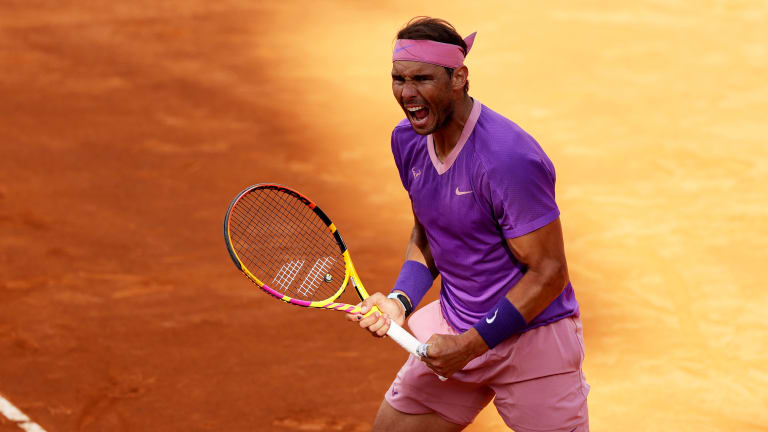Getty Images
There have been times when Nadal has been up a set and a break and promptly lost his serve. This wasn’t one of them. As in the first set, he consolidated emphatically, holding at love to go up 3-1, and again at love to lead 4-2.
One last opportunity for Opelka came with Nadal serving at 5-4, 15-30. Opelka subsequently missed a service return, was wide with an inside-out forehand rally ball and then netted a backhand return.
“I think I played the match that I had to play, no?” said Nadal. “I saved that moment. I had two breaks, two sets. That's a positive thing for me. Be in the final again here means a lot to me.”
Thus ended Reilly’s Roman Odyssey—the best clay tennis of his career. Prior to Rome, Opelka’s career record on clay was 2-10. He’d also gone only 2-7 in 2021, a struggle of a year also marred by a spring bout with COVID-19. So Rome was a breakthrough, Opelka earning straight set wins over Richard Gasquet, Lorenzo Musetti, Aslan Karatsev and Federico Delbonis on the way to his first Tennis Masters 1000 semi. No wonder he looked leg-weary versus Nadal—never a viable physical state for any opponent, much less one of the toughest competitors on the dirt.
There once was a book and a movie titled, “Seven Days in May,” about an attempt to overthrow the American government. Call Nadal’s 2021 Rome, “Four Days in May,” his quest to repel an invasion on the clay. In four consecutive days, the 34-year-old Nadal has beaten a quartet of contenders, each more than a decade younger than him, each armed with significant weapons—weapons built amid the very rise and rule of Nadal, in hope of eventually toppling him.
First, Nadal beat the precocious Italian, Jannik Sinner. Then came an epic comeback from two match points down versus high-energy Canadian, Denis Shapovalov. Yesterday, a straight sets victory over the man who’d just beaten him in Madrid, Alexander Zverev. And today, against an ascending American with one of the best serves in tennis, Nadal again proved masterful.
Assessing his clay-court season thus far, Nadal said, “The rest of the things I have been playing better, worst, but always in a positive line. I mean, playing better when the weeks are coming. Here I had I think a very tough draw and I was able to find a way to be in the final. I know I had to face some very critical moments in my second round against Shapo. That's like this. I fighted.”
When it comes to Nadal, may we apply poetry? There’s the tally, then the rally. The tally is the incredible set of numbers affixed to his resume. The one at hand: Nadal tomorrow will try to win Rome for the tenth time—one of the many statistical achievements tennis aficionados take into account when assessing his brilliance.
So what of the rally? If fans ponder the tally, the rally is where Nadal lives. Sitting years ago in a Los Angeles locker room, I watched a 38-year-old Jimmy Connors field questions at a press conference. One inquiry cited several of Connors’ career achievements.“That’s all well and good,” said Connors.“But I can’t spend time thinking about that. The only thing I can think about is the match I’m playing tomorrow.”
This is how Nadal conducts himself. Likely, at moments away from tournaments, he’s certainly well aware of all the history he has made. But history is pondered backwards. Life is lived forwards, in those singular moments of presence Nadal continues to brilliantly occupy.

